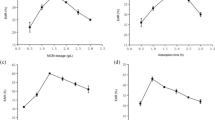Summary
Small diameter alginate beads (microspheres) were formed via internal gelation of alginate solution emulsified within vegetable oil. Gelation was initiated by addition of an oil-soluble acid thereby reducing the pH of the alginate solution and releasing soluble Ca2+ from the citrate complex. Smooth, spherical, micron-sized beads were formed. The mean diameter ranged from 200 to 1000 μm, controlled by the reactor impeller design and rotational speed. The technique has potential for large-scale and continuous applications in immobilization.
Similar content being viewed by others
References
Audet P, Lacroix C (1989) Two-phase dispersion process for the production of biopolymer gel beads: effect of various parameters on bead size and their distribution. Process Biochem 24:217–225
Burns MA, Kvesitadze GI, Graves DJ (1985) Dried calcium alginate/magnetite spheres: a new support for chromatographic separations and enzyme immobilization. Biotechnol Bioeng 27:137–145
Calabrese RV, Wang CY, Bryner NP (1986) Drop breakup in turbulent stirred-tank contactors; part 3: correlations for mean size and drop size distribution. AIChE J 32:677–681
Canon K (1984) Electrostatic image development toners. Japanese patent no. 59 170.853
Champagne CP, Gaudy C, Poncelet D, Neufeld RJ (1991) Lactococcus lactis cell release from calcium alginate beads. Appl Environ Microbiol 58:1429–1434
Chang TMS, MacIntosh FC, Mason SG (1966) Semipermeable aqueous microcapsules. I. Preparation and properties. Can J Physiol Pharmacol 44:115–128
Dabora EK (1967) Production of monodisperse sprays. Rev Sci Instrum 38:502–506
Grace HP (1982) Dispersion phenomena in high viscosity immiscible fluid systems and application of static mixers as dispersion devices in such systems. Chem Eng Commun 14:225–277
Haas PA (1987) Turbulent dispersion of aqueous drops in organic liquids. AIChE J 33:987–995
Hinze JO (1955) Fundamentals of the hydrodynamic mechanism of splitting in dispersion processes. AIChE J 1:289
Hommel M, Sun AM, Goosen MFA (1988) Droplets generation. Canadian patent no. 1241598
Hulst AC, Tramper J, Brodelius P, Eijkenboom LJC, Luyben CAM (1985) Immobilised plant cells: respiration and oxygen transfer. J Chem Technol Biotechnol 35B:198–204
Kennedy JF, Cabral JMS (1983) Immobilized enzymes in solid phase biochemistry. Chem Anal 66:253–392
Kierstan M, Bucke C (1977) The immobilization of microbial cells, subcellular organelles, and enzymes in calcium alginate gels. Biotechnol Bioeng 19:387–397
Lacroix C, Paquin C, Arnaud J-P (1990) Batch fermentation with entrapped growing cells of Lactobacillus casei; optimization of the rheological properties of the entrapment gel matrix. Appl Microbiol Biotechnol 32:403–408
Lencki RWJ, Neufeld RJ, Spinney T (1989) Microspheres and method of producing same. US patent no. 4822534
Lim F (1983) Microcapsules containing viable tissue cells. US patent no. 4391909
Lim F, Sun AM (1980) Microencapsulated islets as bioartificial endocrine pancreas. Science 210:908–910
Miyawaki O, Nakamura K, Yano T (1980) Permeability and molecular sieving characteristics of nylon microcapsule membrane. Agric Biol Chem 44:2865–2870
Neufeld RJ, Peleg Y, Rokem JS, Pines O, Goldberg I (1991) l-Malic acid formation by immobilized Saccaromyces cerevisiae amplified for fumarase. Enzyme Microb Technol 13:991–996
Nilsson K, Scheider W, Katinger HWD, Mosbach K (1986) Production of monoclonal antibodies by agarose-entrapped hybridoma cells. Methods Enzymol 121:352–360
Oldshue JY (1983) Fluid mixing technology. McGraw-Hill, New York, pp 12–14
Pelaez C, Karel M (1981) Improved method for preparation of fruit-simulating alginate gels. J Food Process Preserv 5:63–81
Poncelet D, Poncelet De Smet B, Beaulieu C, Neufeld RJ (1992) Scale-up of gel bead and microcapsule production in cell immobilization. In: Goosen MFA (eds) Fundamentals of animal cell encapsulation and immobilization. CRC Press, Boca Raton, Fla., in press
Poncelet De Smet B, Poncelet D, Neufeld RJ (1989) Control of mean diameter and size distribution during formulation of microcapsules with cellulose nitrate membranes. Enzyme Microb Technol 11:29–37
Poncelet De Smet B, Poncelet D, Neufeld RJ (1990) Preparation of hemolysate-filled hexamethylene sebacamide microcapsules with controlled diameter. Can J Chem Eng 68:443–448
Provost H, Diovies C, Rousseau E (1985) Continuous production with Lactobacillus bulgaricus and Streptococcus thermophilus entrapped in calcium alginate. Biotechnol Lett 7:247–252
Q. P. Corporation (1985) Production of fish egg-like spherical food material. Japanese patent no. JP 60 83.570
Redenbaugh K, Paasch BD, Nichol JW, Kossler ME, Viss PR, Walker KA (1986) Somatic seeds: encapsulation of asexual plant embryos. Bio/Technology 4:797–801
Rounsley RR (1983) Oil dispersion with a turbine mixer. AIChE J 29:597–603
Shiotani T, Yamane T (1981) A horizontal packed-bed bioreactor to reduce carbon dioxide gas holdup in the continuous production of ethanol in immobilized yeast cells. Eur J Appl Microbiol Biotechnol 13:96–101
Smidsrod O, Skjak-Braek G (1990) Alginate as immobilization matrix for cells. Trends Biotechnol 8:71–78
Su H, Bajpai R, Preckshot GW (1989) Characterization of alginate beads formed by a two fluid annular atomizer. Appl Biochem Biotechnol 20/21:561–569
Author information
Authors and Affiliations
Additional information
Correspondence to: R. J. Neufeld
Rights and permissions
About this article
Cite this article
Poncelet, D., Lencki, R., Beaulieu, C. et al. Production of alginate beads by emulsification/internal gelation. I. Methodology. Appl Microbiol Biotechnol 38, 39–45 (1992). https://doi.org/10.1007/BF00169416
Received:
Accepted:
Issue Date:
DOI: https://doi.org/10.1007/BF00169416




